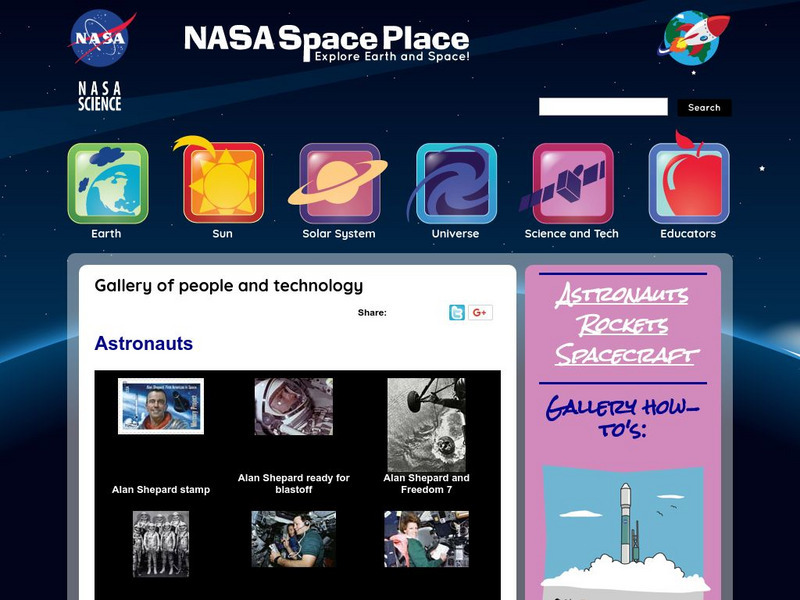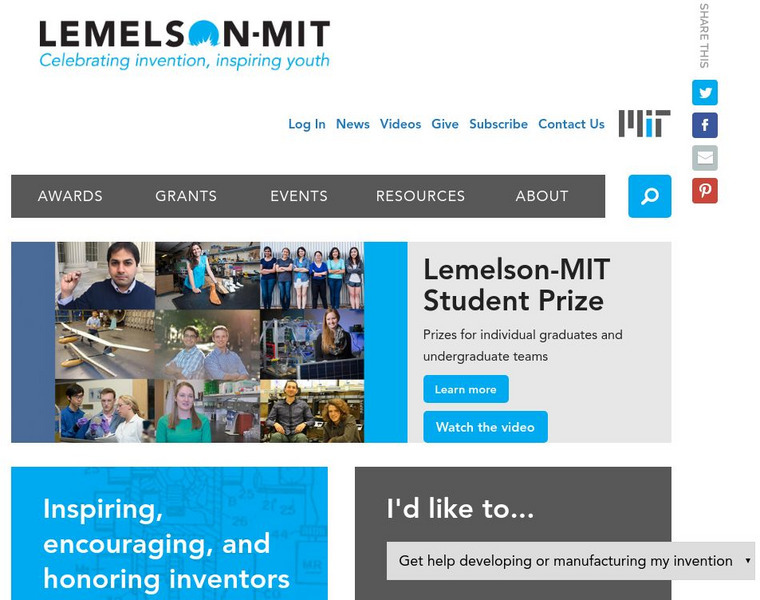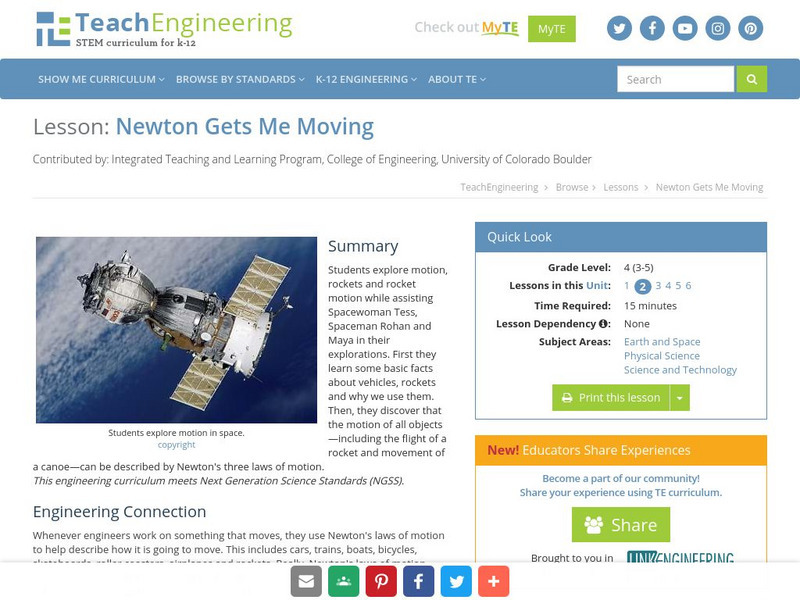NASA
Nasa: The Space Place: Gallery of People and Technology
NASA has provided a whole page full of images for you to download and print. These pictures are labeled and can be enlarged.
Texas Education Agency
Texas Gateway: Linear Momentum and Force: Introduction to Rocket Propulsion
By the end of this section, you will be able to state Newton's third law of motion, explain the principle involved in propulsion of rockets and jet engines, derive an expression for the acceleration of the rocket , discuss the factors...
NASA
Nasa: Rockets Educator Guide: Heavy Lifting
A lesson plan for students to construct balloon powered rockets. Students will be given the same materials to construct their own rocket and then have a contest to see who can launch the highest paperclip from their rocket.
TED Talks
Ted: Ted Ed: Will Future Spacecraft Fit in Our Pockets?
When you picture a rocket, you might imagine a giant ship carrying lots of fuel, people and supplies. But what if the next wave of spacecraft were small enough to fit into our pockets? Dhonam Pemba details the future of microspacecraft,...
Other
Sea Launch
This corporation launches rockets for businesses interested in a cost effective, reliable solution for sending satellites into orbit. Information, images, and detailed specifications can all be found here.
Massachusetts Institute of Technology
Mit: Inventor of the Week: Robert H. Goddard
This brief article overviews the contributions Robert H. Goddard made to the development of liquid-fueled rockets.
NASA
Nasa: Rocket Modeler Iii 1.2h Beta
This NASA program offers users the opportunity to understand rocket design by working with variable values. Java is needed for RocketModeler III 1.2h to run.
Georgia State University
Georgia State University: Hyper Physics: Rockets
HyperPhysics site with dealing with the mathematics of rocket flight. The site is interactive and allows the user to input data. This is a rather high level site and, while any student could use it to get answers, to understand some of...
Science Education Resource Center at Carleton College
Serc: Water Bottle Rockets Understanding Energy
In this activity, students will design and construct a water bottle rocket. Students will demonstrate understanding of a good experimental design and analysis of results.
Science Education Resource Center at Carleton College
Serc: The Optimal Bottle Rocket Launch
Students build rocket models designed for gaining the maximum height. They use a compressed air rocket launcher and 2-liter plastic bottles. They will also use an online simulator to help them make predictions and adjustments to their...
NASA
Nasa: Wernher Von Braun
NASA profiles Wernher von Braun, "one of the most important rocket developers and champions of space exploration during the period between the 1930s and 1970s."
TeachEngineering
Teach Engineering: Strawkets and Thrust
In this activity, students investigate the effect that thrust has on rocket flight. Students will make two paper rockets that they can launch themselves by blowing through a straw. These "strawkets" will differ in diameter, such that...
TeachEngineering
Teach Engineering: Strawkets and Weight
In this activity, students investigate the effect that weight has on rocket flight. Students construct a variety of their own straw-launched rockets, or "strawkets," that have different weights. Specifically, they observe what happens...
TeachEngineering
Teach Engineering: Strawkets and Control
In this activity, students investigate the effect that fins have on rocket flight. Students construct two paper rockets that they can launch themselves by blowing through a straw. One "strawket" has wings and the other has fins. Students...
TeachEngineering
Teach Engineering: Aqua Thrusters!
In this activity, students construct their own rocket-powered boat called an "aqua-thruster." These aqua-thrusters will be made from a film canister and will use carbon dioxide gas - produced from a chemical reaction between an antacid...
TeachEngineering
Teach Engineering: Pop Rockets
Students design and build a paper rocket around a film canister, which is used as the engine. An antacid tablet and water are put into the canister, react to form carbon dioxide gas, and act as the pop rocket's propellant. With the lid...
TeachEngineering
Teach Engineering: Rockets on a Shoestring Budget
In this activity, students revisit the Pop Rockets activity from Lesson 3. This time, however, the design of their pop-rockets will be limited by budgets and supplies. They will get a feel for the limitations of a real engineering...
TeachEngineering
Teach Engineering: Get Me Off This Planet
The purpose of this instructional activity is to teach students about how a spacecraft gets from the surface of the Earth to Mars. The instructional activity first investigates rockets and how they are able to get us into space. Finally,...
TeachEngineering
Teach Engineering: Newton Gets Me Moving
In this instructional activity, learners will explore motion, rockets and rocket motion while assisting Spacewoman Tess, Spaceman Rohan and Maya in their explorations. They will first learn some basic facts about vehicles, rockets and...
TeachEngineering
Teach Engineering: Rocket Me Into Space
One of the exciting challenges for engineers is the idea of exploration. This lesson looks more closely at Spaceman Rohan, Spacewoman Tess, their daughter Maya, and their challenges with getting to space, setting up satellites, and...
TeachEngineering
Teach Engineering: Blast Off
Rockets need a lot of thrust to get into space. In this activity, students learn how rocket thrust is generated with propellant. The two types of propellants are discussed and relation to their use on rockets is investigated. Students...
TeachEngineering
Teach Engineering: Learn to Build a Rocket in 5 Days or Your Money Back
In this instructional activity, students discover the entire process that goes into designing a rocket for any customer. In prior lessons, students learned how rockets work, but now they learn what real-world decisions engineers have to...
CK-12 Foundation
Ck 12: Plix Series: Satellites, Shuttles, and Space Stations
[Free Registration/Login Required] Simulate the launch of a rocket to see how rocket propulsion works. After the activity, answer a challenge question to check for understanding.
Science Education Resource Center at Carleton College
Serc: Mn Step: Why Does It Go So Fast? Investigating Rockets
After reading a book about movement and speed, learners blow up a balloon and release it. During questioning and discussion, they are guided to make a connection between the balloon and a rocket.
Other popular searches
- Model Rocketry
- Newton Rocketry
- Flight and Rocketry
- Advanced Rocketry
- Rocketry Experiments
- Rocketry Payload Experiments
- Model Rocketry Experiments
- Model Rocketry Electronics























